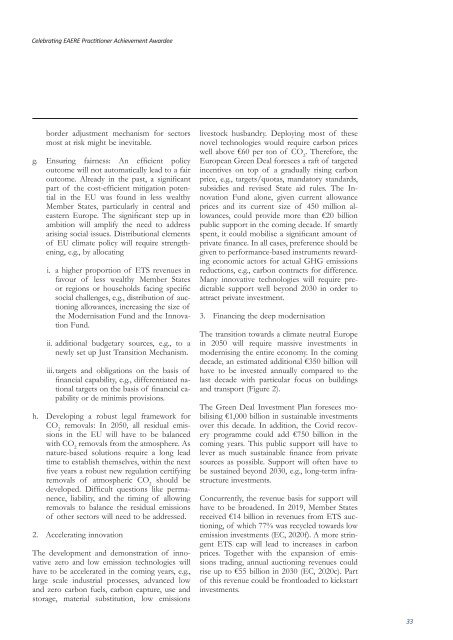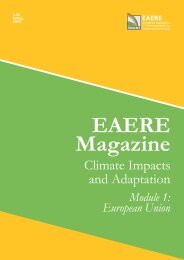You also want an ePaper? Increase the reach of your titles
YUMPU automatically turns print PDFs into web optimized ePapers that Google loves.
Celebrating <strong>EAERE</strong> Practitioner Achievement Awardee<br />
border adjustment mechanism for sectors<br />
most at risk might be inevitable.<br />
g. Ensuring fairness: An efficient policy<br />
outcome will not automatically lead to a fair<br />
outcome. Already in the past, a significant<br />
part of the cost-efficient mitigation potential<br />
in the EU was found in less wealthy<br />
Member States, particularly in central and<br />
eastern Europe. The significant step up in<br />
ambition will amplify the need to address<br />
arising social issues. Distributional elements<br />
of EU climate policy will require strengthening,<br />
e.g., by allocating<br />
i. a higher proportion of ETS revenues in<br />
favour of less wealthy Member States<br />
or regions or households facing specific<br />
social challenges, e.g., distribution of auctioning<br />
allowances, increasing the size of<br />
the Modernisation Fund and the Innovation<br />
Fund.<br />
ii. additional budgetary sources, e.g., to a<br />
newly set up Just Transition Mechanism.<br />
iii. targets and obligations on the basis of<br />
financial capability, e.g., differentiated national<br />
targets on the basis of financial capability<br />
or de minimis provisions.<br />
h. Developing a robust legal framework for<br />
CO 2<br />
removals: In 2050, all residual emissions<br />
in the EU will have to be balanced<br />
with CO 2<br />
removals from the atmosphere. As<br />
nature-based solutions require a long lead<br />
time to establish themselves, within the next<br />
five years a robust new regulation certifying<br />
removals of atmospheric CO 2<br />
should be<br />
developed. Difficult questions like permanence,<br />
liability, and the timing of allowing<br />
removals to balance the residual emissions<br />
of other sectors will need to be addressed.<br />
2. Accelerating innovation<br />
The development and demonstration of innovative<br />
zero and low emission technologies will<br />
have to be accelerated in the coming years, e.g.,<br />
large scale industrial processes, advanced low<br />
and zero carbon fuels, carbon capture, use and<br />
storage, material substitution, low emissions<br />
livestock husbandry. Deploying most of these<br />
novel technologies would require carbon prices<br />
well above €60 per ton of CO 2<br />
. Therefore, the<br />
European Green Deal foresees a raft of targeted<br />
incentives on top of a gradually rising carbon<br />
price, e.g., targets/quotas, mandatory standards,<br />
subsidies and revised State aid rules. The Innovation<br />
Fund alone, given current allowance<br />
prices and its current size of 450 million allowances,<br />
could provide more than €20 billion<br />
public support in the coming decade. If smartly<br />
spent, it could mobilise a significant amount of<br />
private finance. In all cases, preference should be<br />
given to performance-based instruments rewarding<br />
economic actors for actual GHG emissions<br />
reductions, e.g., carbon contracts for difference.<br />
Many innovative technologies will require predictable<br />
support well beyond 2030 in order to<br />
attract private investment.<br />
3. Financing the deep modernisation<br />
The transition towards a climate neutral Europe<br />
in 2050 will require massive investments in<br />
modernising the entire economy. In the coming<br />
decade, an estimated additional €350 billion will<br />
have to be invested annually compared to the<br />
last decade with particular focus on buildings<br />
and transport (Figure 2).<br />
The Green Deal Investment Plan foresees mobilising<br />
€1,000 billion in sustainable investments<br />
over this decade. In addition, the Covid recovery<br />
programme could add €750 billion in the<br />
coming years. This public support will have to<br />
lever as much sustainable finance from private<br />
sources as possible. Support will often have to<br />
be sustained beyond 2030, e.g., long-term infrastructure<br />
investments.<br />
Concurrently, the revenue basis for support will<br />
have to be broadened. In 2019, Member States<br />
received €14 billion in revenues from ETS auctioning,<br />
of which 77% was recycled towards low<br />
emission investments (EC, 2020f). A more stringent<br />
ETS cap will lead to increases in carbon<br />
prices. Together with the expansion of emissions<br />
trading, annual auctioning revenues could<br />
rise up to €55 billion in 2030 (EC, 2020c). Part<br />
of this revenue could be frontloaded to kickstart<br />
investments.<br />
33













